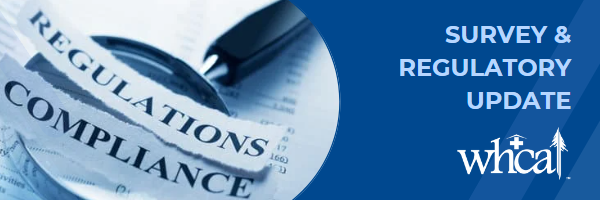Resident Smoking
Smoking is still a topic that is fraught with personal opinions, safety hazards, resident rights, and multiple regulations. Every facility needs to remain hypervigilant related to smoking, whether or not the facility “permits” resident smoking. Included in the Centers for Medicare & Medicaid Services (CMS) State Operations Manual (SOM) Appendix Q-Guidelines for Determining Immediate Jeopardy are triggers that include unsupervised resident smoking with known safety risks (failure to prevent neglect) and smoking in high risk areas (failure to provide safety from fire, smoke and environment hazards).
According to the Code of Federal Regulation (CFR) 483.90 Physical Environment (F926), the facility must establish policies, in accordance with applicable federal, state, and local laws and regulations, regarding smoking, including tobacco cessation, smoking areas and safety, for both smoking and non-smoking residents. CMS directs surveyors to look for signs of smoking by residents, staff, visitors, guests, and non-staff, as well as to look for smoking areas both inside and outside the facility. It is imperative that facilities take a proactive and routine maintenance approach in monitoring these same issues even if they are a “non-smoking” facility. Do visitors, staff, and/or residents discard their cigarette butts in flower gardens, decorative bark, or trash receptacles before entering the facility? Are there places around the corner or behind dumpsters where people are known to congregate for a quick smoke? These areas need to be monitored and addressed accordingly.
If your facility allows smoking or if there is evidence of smoking, you can expect the surveyors to interview and observe residents regarding smoking in the facility. They will ask if the facility allows smoking and how smoking is managed, as well as review the policies and procedures. In facilities that allow smoking of tobacco and/or cannabis products, assessment of each resident’s capabilities and deficits determines whether or not supervision is required. If the facility finds that the resident needs assistance and supervision for smoking, the facility must include this information in the resident’s plan of care. The resident must also be reassessed when circumstances or changes occur that affect or may alter their cognitive and physical capabilities (see CFR 483.25(d) Accidents/F689 for additional information). This can include such things as a change in medication regime, cognitive and/or physical decline, delirium, mental health changes, etc. The plan of care must be changed accordingly, and the necessary supervision/assistance implemented to address the situation and protect all residents’ safety. This may mean providing whatever supervision and/or support is necessary until alternatives are explored. For example, a resident may return from a medical procedure and still be under the influence of sedation. As soon as they get back to the facility, the resident may want to go outside to smoke. Are they safe to do so? Do staff on weekends and off-hours know how to manage this situation? It is not enough to repeatedly “remind” the resident not to smoke when it is known they are non-compliant or do not have the cognitive abilities to remember.
Facility policies must describe the methods by which residents are considered safe to smoke without supervision. These methods may include, but are not limited to, assessment of a resident’s cognitive ability, judgement, manual dexterity, and mobility. According to CMS, facilities should err on the side of caution and provide staff, family, or volunteer supervision when unsure whether or not a resident is safe to smoke unsupervised. Facilities are directed to also ensure resident safety by such efforts as informing visitors of smoking policies and hazards to prevent smoking-related incidents and/or injuries.
While most facilities over the years have chosen to go “non-smoking,” it is important to remember a change in the facility’s policy to prohibit smoking does not affect current residents who smoke. According to CMS and state agency guidance, current residents are to be allowed to continue smoking in an outside, designated area. Part of the facility’s obligation to ensure the safety of designated areas includes protection of residents from weather conditions, non-smoking residents from secondhand smoke, portable fire extinguishers, and ashtrays made of noncombustible material and safe design. Metal containers with self-closing covers into which ashtrays can be emptied must be readily available.
Further guidance regarding resident smoking regulations can be found in NFPA 101, the Life Safety Code at 19.7.4, which addresses smoking, requirements for signage, prohibiting smoking by residents classified as not safe/responsible, and disposal of smoking materials. Also, see CMS S&C Memo 12-04-NH, Alert: Smoking Safety in Long Term Care Facilities and the DSHS/ALTSA Dear Administrator Letter NH #2015-030, Use of Electronic-Cigarettes in Long Term Care Facilities for additional information. Also, the Dear Administrator letter NH# 2015-014 addresses the use of cannabis.
If you have questions, please email Elena Madrid or call her at (800) 562-6170, extension 105.
Posted in Skilled Nursing Facilities, Survey & Regulatory

